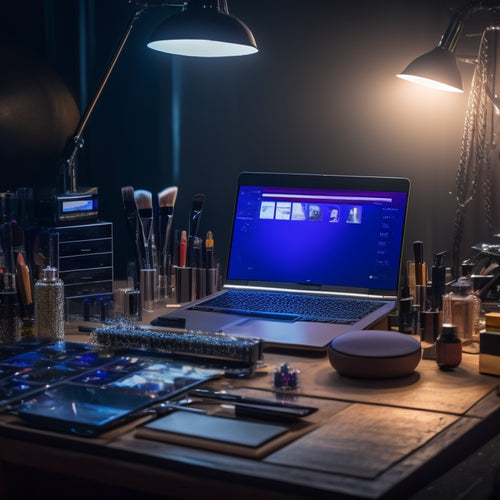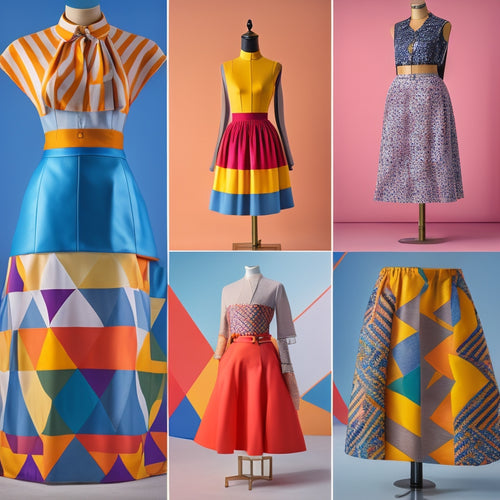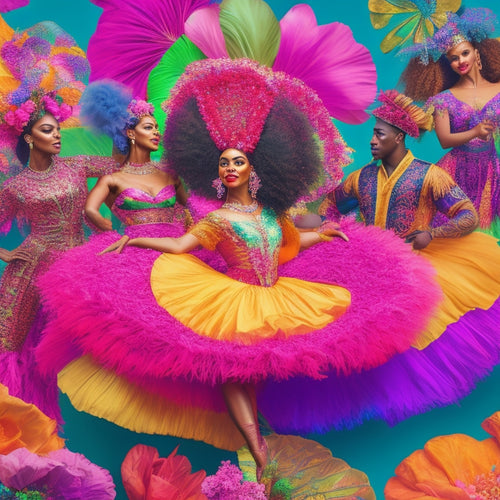
5 Best Flash Lighting Tips for Belly Dance Photography
Share
When shooting belly dance photography, you'll want to master flash exposure control by adjusting settings and experimenting with modes for unique effects. Soften harsh shadows by positioning your light source at a 45-degree angle and using diffused reflectors. Create dramatic effects by strategically placing your flash unit and combining backlighting with light painting. Synchronize your flash with the dancer's movements to freeze motion, and balance flash with ambient light to avoid harsh shadows. By applying these techniques, you'll capture the dynamic energy and intricate details of belly dance - and that's just the beginning of your creative journey.
Key Takeaways
• Set flash unit to slave mode and sync with camera to ensure precise exposure control for dynamic belly dance movements.
• Position flash unit strategically to craft dramatic effects, using backlighting to separate dancer from background.
• Synchronize flash with dancer's movements to freeze motion, adjusting flash power to balance with ambient light.
• Experiment with flash placement for dramatic shadows and highlights, triggering flash at peak of dancer's motion for dynamic energy.
• Balance flash with ambient light by adjusting Flash Priority settings, using ambient light to soften flash in indoor settings.
Mastering Flash Exposure Control
Mastering Flash Exposure Control
Set your flash unit to slave mode and sync it with your camera to guarantee a precise exposure control, enabling you to capture the dynamic movements of the belly dancer without being restricted by the flash's automatic settings. This allows you to take creative control, making adjustments as needed to achieve the desired effect.
In slave mode, your flash unit will fire in sync with your camera's shutter, ensuring a precise exposure every time. Understanding Flash Modes is essential in achieving this level of control. You'll want to experiment with different modes, such as Rear-Curtain Sync or Slow Sync, to create unique effects.
Additionally, paying attention to your camera's Sync Speed is crucial, as it determines the maximum shutter speed at which your flash can sync with the camera. By mastering these settings, you'll be able to capture the intricate details and dynamic movements of the belly dancer with precision and power.
With practice and patience, you'll enhance the full potential of your flash unit, taking your belly dance photography to the next level.
Softening Harsh Shadows Naturally
When working with flash lighting, you can soften harsh shadows naturally by positioning your light source at a 45-degree angle to your subject, which helps to create a more flattering, wraparound light that reduces the appearance of deep shadows. This technique is especially useful when shooting belly dance photography, where harsh shadows can detract from the dancer's movements and overall aesthetic.
To take it a step further, consider the following tips to soften harsh shadows naturally:
-
Use a Diffused Reflector: Attach a diffused reflector to your flash unit to scatter the light and reduce harsh shadows.
-
Employ Natural Filters: Take advantage of natural filters like sheer fabrics, lace, or leaves to soften the light and create a more romantic ambiance.
-
Shoot Near a Window: Position your subject near a window to utilize natural light, which can help soften harsh shadows.
- Experiment with Angles: Don't be afraid to experiment with different angles and positions to find the most flattering light for your subject.
Creating Dramatic Lighting Effects
By strategically positioning your flash unit and adjusting its power output, you can craft dramatic lighting effects that accentuate the sensuality and energy of belly dance movements.
To create a sense of dynamism, try using backlighting to separate your dancer from the background. This technique adds depth and dimension to your image, making the dancer's movements appear more fluid and energetic.
For a more avant-garde approach, experiment with Light Painting, where you intentionally move the flash during exposure to create streaks of light that echo the dancer's movements. This technique can result in mesmerizing, abstract patterns that amplify the emotional intensity of the performance.
To take it up a notch, combine backlighting with Light Painting to create an otherworldly atmosphere. By mastering these techniques, you'll be able to capture the essence of belly dance – a fusion of strength, grace, and sensuality – and convey its raw energy to your audience.
Using Flash to Enhance Movement
To freeze the dynamic motion of belly dance movements, you'll want to synchronize your flash with the dancer's movements, creating a sharp, high-contrast image that captures the intricate details of the performance. This technique allows you to showcase the dancer's agility, strength, and grace, while minimizing motion blur effects.
When using flash to enhance movement, consider the following key factors:
-
Sync speed: Guarantee your camera's sync speed is set to match the flash's duration, typically around 1/200s to 1/800s.
-
Flash power: Adjust the flash power to balance with the ambient light, avoiding overexposure and harsh shadows.
-
Angle and position: Experiment with flash placement to create dramatic shadows and highlights that accentuate the dancer's movements.
- Timing: Anticipate the dancer's movements and trigger the flash at the peak of their motion, capturing the dynamic energy of the performance.
Balancing Flash With Ambient Light
Mastering the art of synchronizing your flash with the dancer's movements, you're now prepared to tackle the delicate balance between flash and ambient light, which can make or break the mood and atmosphere of your belly dance photography.
Balancing flash with ambient light is a nuanced process, requiring a deep understanding of how these two light sources interact. To achieve a Natural Harmony, you'll need to carefully adjust your Flash Priority settings to complement the existing ambient light.
When working indoors, you can often use the ambient light to your advantage, allowing it to soften the harshness of the flash. However, in low-light environments, you may need to crank up the flash power to compensate. Here, maintaining a balance between flash and ambient light is crucial to avoid harsh shadows or overly bright highlights.
Frequently Asked Questions
What Is the Ideal Flash Sync Speed for Belly Dance Photography?
Did you know that 80% of photographers struggle with flash sync speed? You'll master the ideal flash sync speed for belly dance photography by setting your camera to Shutter Priority mode, balancing Flash Power with a sync speed of 1/125s to 1/200s, capturing dynamic movements with precision.
Can I Use a Single Flash Unit for a Full-Body Shot?
When you're capturing a full-body shot, using a single flash unit can work, but consider the flash distance: if it's too far, the light will be harsh; instead, opt for a softbox effect to soften the light and create a more flattering, wrap-around illumination.
How Do I Avoid the "Deer in Headlights" Look With Flash?
As you master the art of flash photography, you'll want to avoid the dreaded "deer in headlights" look by positioning your flash at a 45-degree angle, increasing flash distance to soften the light, and exploiting the softening effect to create a more natural, radiant glow.
What Is the Best Flash Mode for Capturing Fast Movements?
When capturing fast movements, you'll want to use rear curtain sync mode, which fires the flash at the end of the exposure, creating a more natural motion blur and freeze frame effect, freezing the action.
Can I Mix Flash With Natural Light for Outdoor Shoots?
As you step out into the golden hour, you're tempted to merge the sun's warm glow with artificial light, wondering if you can mix flash with natural light for outdoor shoots, creating dramatic Sunset Silhouettes with Flash Fill.
Related Posts
-

3 Essential Tools for Dance Makeup Artists Online
As a dance makeup artist, you already possess the skills to create stunning looks, and with the right digital tools, ...
-

Top Geometric Print Skirts to Update Your Wardrobe
To update your wardrobe with stunning geometric print skirts, look for bold colors and unique patterns that turn head...
-

Dance Dress Code: Unleash Your Style
A dance dress code that prioritizes functionality and technical precision can often stifle dancers' ability to expres...


